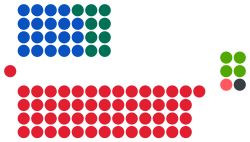
Back برلمان ولاية فيكتوريا Arabic Parlament von Victoria German Parlement de Victoria French विक्टोरियन संसद Hindi ビクトリア州議会 Japanese Victorias parlament NB Parlament Wiktorii Polish Parliament of Victoria SIMPLE
The Parliament of Victoria is the bicameral legislature of the Australian state of Victoria that follows a Westminster-derived parliamentary system. It consists of the King, represented by the governor of Victoria, the Legislative Assembly and the Legislative Council.[1] It has a fused executive drawn from members of both chambers.[2] The parliament meets at Parliament House in the state capital Melbourne. The current Parliament was elected on 26 November 2022, sworn in on 20 December 2022 and is the 60th parliament in Victoria.
The two Houses of Parliament have 128 members in total, 88 in the Legislative Assembly (lower house) and 40 in the Legislative Council (upper house). Victoria has compulsory voting and uses instant-runoff voting in single-member seats for the Legislative Assembly, and single transferable vote in multi-member seats for the proportionally represented Legislative Council. The council is described as a house of review. Majorities in the Legislative Council are rare, so the government of the day must negotiate with other parties to pass much of its legislative agenda. All members serve four-year terms. The parliament's functions and processes have evolved over time, undergoing significant changes as Victoria changed from an independent colony to a state within the federated Australia.[3]
The Parliament may make laws for any matter within Victoria, subject to some referendum requirements in the Victorian Constitution. Its power is further limited by the ability for the federal laws to override state laws, subject to the Australian Constitution. State courts are responsible for interpreting the laws of Parliament, subject to appeal to the High Court of Australia. The parliament is also vested with other powers, such as the means to investigate matters, conduct research and summon witnesses.[4]
Government is formed by the party or parties who command confidence and supply within the Assembly. The leader of the governing party or parties is the Premier, the most senior elected member of Victoria's executive government. Victorians do not directly elect the Premier, and the leader of the majority party is appointed Premier by the Governor. Jacinta Allan has been the Premier since her selection as leader of the Labor Party on 27th September 2023.[5]
- ^ Constitution Act 1975 (Vic) s 15
- ^ Constitution Act 1975 (Vic) s 51
- ^ Cite error: The named reference
povfactsheetwas invoked but never defined (see the help page). - ^ Constitution Act 1975 (Vic) s 19
- ^ "Jacinta Allan replaces Daniel Andrews as Victorian premier after tense Labor meeting". ABC News. 27 September 2023. Retrieved 27 September 2023.
© MMXXIII Rich X Search. We shall prevail. All rights reserved. Rich X Search




